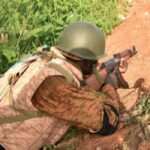“Some people change when they see the light; others when they feel the heat”. –Caroline Schoeder, former U.S. Congress member
Viewpoint by Rene Wadlow, President, Association of World Citizens
GENEVA (IDN) – The UN Security Council Resolution 1325 of 2000 is a commitment to work resolutely toward greater protection of women and girls in conflict zones, to appoint more women in UN peacekeeping operations and ensuring that women would increasingly become more active participants in decision-making processes, especially at “peace table” negotiations.
On 31 October 31, 2000, the UN Security Council adopted the resolution. It was the first time that the UN had fully identified women as constructive agents of peace, security, and post-conflict reconstruction. The Resolution helped to bring attention to the underutilized and perhaps undervalued contribution that women have been making to prevent war and to building the foundations of peace.
The hope was that the Resolution could make a real difference in the transition from a cult of war to a culture of peace. On the anniversary of Resolution 1325, it is useful to look at its impact and at the road yet to travel.
Security Council Resolution 1325 is not a treaty; consequently, there are no mechanisms for ratification, compliance or national reporting. Thus it has been largely left to non-governmental organizations (NGOs) to monitor compliance. Implementation of Resolution 1325 has been erratic, even within the highly militarized organizational culture that permeates the UN’s peacekeeping structures. Women are seen as victims in need of protection while men are seen as the protectors and the policy makers.
I have tried to follow – from a distance – three current armed conflicts: Yemen, Syria-Iraq-Kurdistan-Turkey, and Ukraine-Russia and have made proposals for negotiated settlements and decentralized, con-federal structures of government on behalf of the Association of World Citizens.
From the edges, I have been able to observe some of the Syria negotiations carried out at the United Nations in Geneva or in Lausanne. Colleagues have been to refugee camps in Jordan, Turkey, and Iraqi Kurdistan and spoken with aid workers and some refugees. Other colleagues have been in close contact with refugees in exile in Paris.
In these conflicts, there seems to have been no special protection of women and girls when civilians have been attacked. Perhaps it is impossible when attacking civilian targets to make a distinction between men and women, but then the pretext of “women and children first” should be dropped.
The issue is one of the protection of all civilians. However, the special needs of women and girls should be taken into account when there is a possibility for a return of refugees, their reintegration and post armed-conflict reconstruction.
Likewise in the on-again/off-again negotiations concerning Yemen and Syria both with UN mediators, there are few if any women seated at the negotiating table. It is not sure that there is much of a negotiating table in any case. It is not clear to me that negotiations would make more progress if there were women present. I sense an unwillingness to compromise or even to set an agenda on which compromises could be made although negotiations on constitutional changes in Syria should start in Geneva early November. We will try to follow them closely.
While it is useful, even important, that governments present in the UN set out clearly values and norms, there are limits to the impact of top-down resolutions. Many people have the feeling that diplomats, like other political officials, “do not understand them” – “do not live in the same world”. This is particularly true when all the diplomats are men and operate within the same UN bureaucracy.
Thus we need to focus on how to raise the impact of local grass-roots initiatives to a broader and higher level. Women have often been present in efforts of local peacemaking, in establishing local ceasefires, or the evacuation of non-combatants. Women have taken the lead in some cases. Such local initiatives show that compromises and bridge-building is possible.
However such initiatives are usually not wide enough to have an impact on the region, much less at the national level. Yet there is a growing realization of women as “agents of change”, often at great personal risk as we have seen in the change of leadership in Sudan. The participation of women in a peace process is not only for the elite; it is also for the women directly affected by conflict, such as refugees, internally-displaced and survivors of violence.
There is a need to study how to overcome the cultural barriers, the traditional patriarchal attitudes that prevent women from playing a full role in armed-conflict resolution and to strengthen the capacities of women-led initiatives. [IDN-InDepthNews – 30 October 2019]
IDN is flagship agency of the International Press Syndicate.









